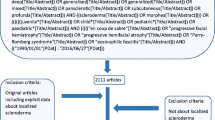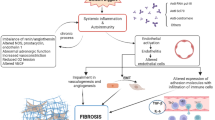Abstract
There is huge variation in the evaluation, diagnosis, and treatment of patients with morphea (localized scleroderma). In part, this variability results from the lack of validated methods to assess severity and outcomes with a consequent lack of adequate therapeutic trials. Evaluation is also hindered by lack of information regarding the impact of morphea on patients. Recent studies are addressing this gap in knowledge and include: development of clinical outcome measures, validation of imaging studies, publication of consensus treatment plans, and increased understanding of the impact of morphea on patients and parents. The purpose of this review is to summarize the results of these studies and to synthesize the information into a rational approach to the diagnosis and assessment of patients with morphea.

Similar content being viewed by others
References
Papers of particular interest, published recently, have been highlighted as: • Of importance •• Of major importance
• Johnson W, Jacobe H: Morphea in adults and children (MAC) cohort II: Patients with morphea experience delay in diagnosis and large variation in treatment. J Am Acad Dermatol 2012 Feb 28. [Epub ahead of print]. This cross sectional survey of patients enrolled in the Morphea in Adults and Children Cohort underscores often significant delays in diagnosis and treatment of patients with morphea. Further, treatments prescribed for patients varied largely dependent on the specialty of treating physician. The results of this study support the need for treatment plans accepted across specialties.
Weibel L, Laguda B, Atherton D, Harper JI. Misdiagnosis and delay in referral of children with localized scleroderma. Br J Dermatol. 2011;165:1308–13.
Li SC, Torok KS, Pope E, et al. Development of consensus treatment plans for juvenile localized scleroderma. Arthritis Care Res. 2012;64:1175–85.
Zulian F, Athreya BH, Laxer R, et al. Juvenile localized scleroderma: clinical and epidemiological features in 750 children. An international study. Rheumatology (Oxford). 2006;45:614–20.
• Saxton-Daniels S, Jacobe HT: An evaluation of long-term outcomes in adults with pediatric-onset morphea. Arch Dermatol 2010, 146:1044-5. This cross-sectional survey of adults with pediatric onset morphea in the Morphea in Adults and Children Cohort is one of the first to report continued episodes of active morphea well into adulthood of these patients. The study also reports significant impact on life quality in these patients which was associated with the number of lesions and presence of functional impairment. These findings indicate children with morphea will require close follow-up into adulthood.
Jacobe H: Treatment of morphea (localized scleroderma) in adults. UpToDate, Basow, DS (Ed), Waltham, MA 2012, Available at: http://www.uptodate.com/contents/treatment-of-morphea-localized-scleroderma-in-adults?source=search_result&search=morphea&selectedTitle=2%7E34
Skobieranda K, Helm KF. Decreased expression of the human progenitor cell antigen (CD34) in morphea. Am J Dermatopathol. 1995;17:471–5.
McNiff JM, Glusac EJ, Lazova RZ, Carroll CB. Morphea limited to the superficial reticular dermis: an underrecognized histologic phenomenon. Am J Dermatopathol. 1999;21:315–9.
Sung JJ, Chen TS, Gilliam AC, et al. Clinicohistopathological correlations in juvenile localized scleroderma: studies on a subset of children with hypopigmented juvenile localized scleroderma due to loss of epidermal melanocytes. J Am Acad Dermatol. 2011;65:364–73.
Stewart L, Nuara A, Anand D, et al. Perifollicular papules and hyperkeratotic plaques on the back in a blaschkoid distribution. Morphea with features of lichen sclerosus et atrophicus (LS). Arch Dermatol. 2011;147:857–62.
Sherber NS, Boin F, Hummers LK, Wigley FM. The "tank top sign": a unique pattern of skin fibrosis seen in pansclerotic morphea. Ann Rheum Dis. 2009;68:1511–2.
Li SC, Liebling MS. The use of Doppler ultrasound to evaluate lesions of localized scleroderma. Curr Rheumatol Rep. 2009;11:205–11.
Bendeck SE, Jacobe HT. Ultrasound as an outcome measure to assess disease activity in disorders of skin thickening: an example of the use of radiologic techniques to assess skin disease. Dermatol Ther. 2007;20:86–92.
Lott JP, Girardi M. Practice gaps. The hard task of measuring cutaneous fibrosis: comment on "14-MHz ultrasonography as an outcome measure in morphea (localized scleroderma)". Arch Dermatol. 2011;147:1115–6.
Nezafati KA, Cayce RL, Susa JS, et al. 14-MHz ultrasonography as an outcome measure in morphea (localized scleroderma). Arch Dermatol. 2011;147:1112–5.
•• Wortsman X, Wortsman J, Sazunic I, Carreno L: Activity assessment in morphea using color Doppler ultrasound. J Am Acad Dermatol 2011, 65:942-8. This study reports ultrasound features associated with disease activity in morphea. This is helpful reading when considering referring patients for ultrasound evaluation, as the radiologists performing the scan should be familiar with these changes.
Li SC, Liebling MS, Ramji FG, et al. Sonographic evaluation of pediatric localized scleroderma: preliminary disease assessment measures. Pediatr Rheumatol Online J. 2010;8:14.
Li SC, Liebling MS, Haines KA, et al. Initial evaluation of an ultrasound measure for assessing the activity of skin lesions in juvenile localized scleroderma. Arthritis Care Res (Hoboken). 2011;63:735–42.
Horger M, Fierlbeck G, Kuemmerle-Deschner J, et al. MRI findings in deep and generalized morphea (localized scleroderma). AJR Am J Roentgenol. 2008;190:32–9.
•• Schanz S, Fierlbeck G, Ulmer A, et al.: Localized scleroderma: MR findings and clinical features. Radiology 2011, 260:817-24. This cross-sectional study of patients with morphea documents the typical finding on MR imaging of morphea lesions with suspected musculoskeletal involvement. Surprisingly, many patients who did not have any symptoms or physical examination findings suggestive of musculoskeletal involvement had MRI changes suggestive of involvement. The clinical significance of these occult changes is uncertain, but the results demonstrate the utility of MRI when musculoskeletal involvement is suspected.
Arkachaisri T, Vilaiyuk S, Li S, et al. The localized scleroderma skin severity index and physician global assessment of disease activity: a work in progress toward development of localized scleroderma outcome measures. J Rheumatol. 2009;36:2819–29.
Arkachaisri T, Vilaiyuk S, Torok KS, Medsger Jr TA. Development and initial validation of the localized scleroderma skin damage index and physician global assessment of disease damage: a proof-of-concept study. Rheumatology (Oxford). 2010;49:373–81.
Jacobe H, Saxton-Daniels S: Morphea. Chapter 64. In: Fitzpatrick's Dermatology in General Medicine, 8e. Edited by Goldsmith, et al. New York: McGraw-Hill; 2012:692-701.
Dharamsi J: Morphea in adults and children (MAC) cohort III: The prevalence and clinical significance of autoantibodies in morphea: A prospective case-control survey. Texas Dermatological Society annual meeting May 2012
Baildam EM, Ennis H, Foster HE, et al. Influence of childhood scleroderma on physical function and quality of life. J Rheumatol. 2011;38:167–73.
Carlomagno R, Russo G, Forni C, et al. Childhood morphea does not impair self-perception. Pediatr Rheumatol. 2011;9:78.
Ennis H, Herrick AL, Baildam EM, Richards HL. Childrens' and parents' beliefs about childhood onset scleroderma are influenced by child age and physical function impairment. Rheumatology (Oxford). 2012;51:1331–3.
Laxer RM, Zulian F. Localized scleroderma. Curr Opin Rheumatol. 2006;18:606–13.
Disclosure
No potential conflicts of interest relevant to this article were reported.
Author information
Authors and Affiliations
Corresponding author
Additional information
This article is part of the Topical Collection on Scleroderma
Rights and permissions
About this article
Cite this article
Nouri, S., Jacobe, H. Recent Developments in Diagnosis and Assessment of Morphea. Curr Rheumatol Rep 15, 308 (2013). https://doi.org/10.1007/s11926-012-0308-9
Published:
DOI: https://doi.org/10.1007/s11926-012-0308-9




